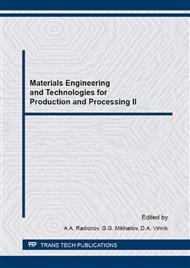p.226
p.234
p.239
p.243
p.248
p.253
p.259
p.265
p.271
Tin and Nickel Influence on the Structure and Properties of the Leaded Bronze Obtained by Means of the Centrifugal Casting
Abstract:
The effect of tin and nickel on the structure and properties of the leaded bronze obtained by means of the centrifugal casting has been studied. Regularities of change of strength properties and ductility explain the features of the structure formation under the influence of nickel and tin. The paper demonstrates that introduction of nickel promotes a uniform distribution of the plate-shaped lead in the interdendritic space. Introduction of tin sufficient for the formation of eutectoid results in a uniform and compact arrangement of lead in the intergranular space. Complex alloying with nickel and tin contributes to strength characteristics increase.
Info:
Periodical:
Pages:
248-252
Citation:
Online since:
September 2016
Authors:
Price:
Сopyright:
© 2016 Trans Tech Publications Ltd. All Rights Reserved
Share:
Citation:


